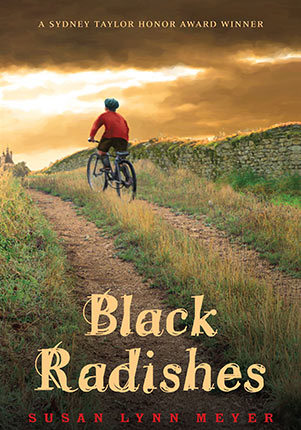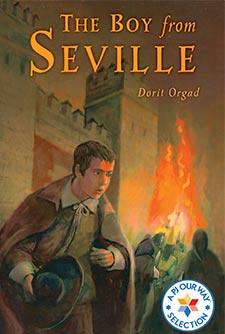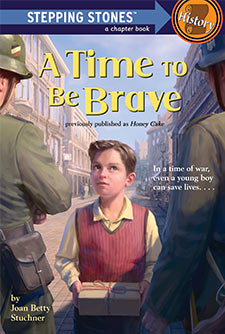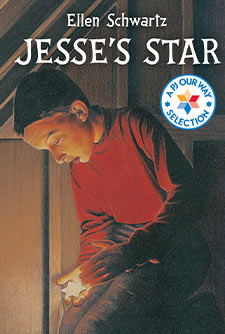Black Radishes
When the Germans arrive in France, Gustave and his family flee to the countryside, leaving his best friends, Marcel and Jean Paul, back in Nazi-occupied Paris. Can Gustave help his friends? And will the Eagles win the Boy Scout trophy without him?
Average Rating
( hint: Login to leave a review! )
146 Reviews
Leave Review
What the Book is About
Jewish Content & Values
Positive Role Models
Content Advisory
Talk it Over!
More for You
Gustave and his family are French Jews, living in Paris in 1940. In an effort to escape the Nazis as they invade France, they flee to the unoccupied zone in the countryside, leaving friends and family behind. This story has plenty of kid appeal as we learn of Gustave’s exploits with his friends and his challenges with anti-Semites at school. With the help of the French Resistance and some black radishes that the German soldiers particularly enjoy, Gustave and his family eventually manage to escape to America. There's plenty of Jewish content in this well-written story, and the Holocaust details are age-appropriate and gripping.
- Gustave’s family celebrates Shabbat and the High Holy Days Rosh Hashanah and Yom Kippur, and they do so even when it is dangerous.
- Gustave, his father, and Gustave’s friend Nicole all demonstrate moral courage (ometz lev) by traveling into the occupied zone in order to try to rescue friends and family.
- Gustave experiences anti-Semitism in Paris when a woman spits at him and calls him a dirty Jew, as well as when he comes out of synagogue and sees the words ‘Jews out of France’ painted on the street. Some of the schoolboys in the countryside make anti-Semitic remarks.
- Gustave is proud to be Jewish. He is determined to find a way to rescue his best friends from occupied Paris. He courageously paints V-signs on walls as a gesture of Resistance against the Nazi occupiers.
- Gustave’s friend Nicole is Catholic and is active in the Resistance. She too risks her safety, painting V-signs and symbols of Free France, and she undertakes important Resistance work helping Jews get from the occupied zone into unoccupied France.
The anti-Semitism that Gustave experiences may be mildly disturbing for readers, but it is not too graphic or upsetting for this age group. There are references to deportations and concentration camps and several anxious encounters with German soldiers. Although there are no graphic descriptions, it is very clear to the reader that it is dangerous to be a Jew in France during World War II.
Gustave’s father takes him on a dangerous journey from free France into the Nazi-occupied zone. Do you think it was right for him to risk Gustave’s life in this way? If you were Gustave, would you want to make this journey? Why or why not?
Most Americans are familiar with red radishes, but black radishes were historically the radish used most often in Jewish cooking. Black radishes were said to have been a favorite food of the Maccabees, and because of this they were later used in Hanukkah dishes. A classic Jewish dish of grated black radish, chicken fat, onion, salt, and pepper was common in 19th-century Lithuania, Ukraine, and northern Poland. In the story “Tevye Goes to Palestine” by Sholem Aleichem (Fiddler on the Roof was based on the Tevye stories), Tevye refers to Eretz Israel as “the place where black radishes and chicken fat are not eaten.”
What the Book is About
Gustave and his family are French Jews, living in Paris in 1940. In an effort to escape the Nazis as they invade France, they flee to the unoccupied zone in the countryside, leaving friends and family behind. This story has plenty of kid appeal as we learn of Gustave’s exploits with his friends and his challenges with anti-Semites at school. With the help of the French Resistance and some black radishes that the German soldiers particularly enjoy, Gustave and his family eventually manage to escape to America. There's plenty of Jewish content in this well-written story, and the Holocaust details are age-appropriate and gripping.
Jewish Content & Values
- Gustave’s family celebrates Shabbat and the High Holy Days Rosh Hashanah and Yom Kippur, and they do so even when it is dangerous.
- Gustave, his father, and Gustave’s friend Nicole all demonstrate moral courage (ometz lev) by traveling into the occupied zone in order to try to rescue friends and family.
- Gustave experiences anti-Semitism in Paris when a woman spits at him and calls him a dirty Jew, as well as when he comes out of synagogue and sees the words ‘Jews out of France’ painted on the street. Some of the schoolboys in the countryside make anti-Semitic remarks.
Positive Role Models
- Gustave is proud to be Jewish. He is determined to find a way to rescue his best friends from occupied Paris. He courageously paints V-signs on walls as a gesture of Resistance against the Nazi occupiers.
- Gustave’s friend Nicole is Catholic and is active in the Resistance. She too risks her safety, painting V-signs and symbols of Free France, and she undertakes important Resistance work helping Jews get from the occupied zone into unoccupied France.
Content Advisory
The anti-Semitism that Gustave experiences may be mildly disturbing for readers, but it is not too graphic or upsetting for this age group. There are references to deportations and concentration camps and several anxious encounters with German soldiers. Although there are no graphic descriptions, it is very clear to the reader that it is dangerous to be a Jew in France during World War II.
Talk it Over!
Gustave’s father takes him on a dangerous journey from free France into the Nazi-occupied zone. Do you think it was right for him to risk Gustave’s life in this way? If you were Gustave, would you want to make this journey? Why or why not?
More for You
Most Americans are familiar with red radishes, but black radishes were historically the radish used most often in Jewish cooking. Black radishes were said to have been a favorite food of the Maccabees, and because of this they were later used in Hanukkah dishes. A classic Jewish dish of grated black radish, chicken fat, onion, salt, and pepper was common in 19th-century Lithuania, Ukraine, and northern Poland. In the story “Tevye Goes to Palestine” by Sholem Aleichem (Fiddler on the Roof was based on the Tevye stories), Tevye refers to Eretz Israel as “the place where black radishes and chicken fat are not eaten.”




